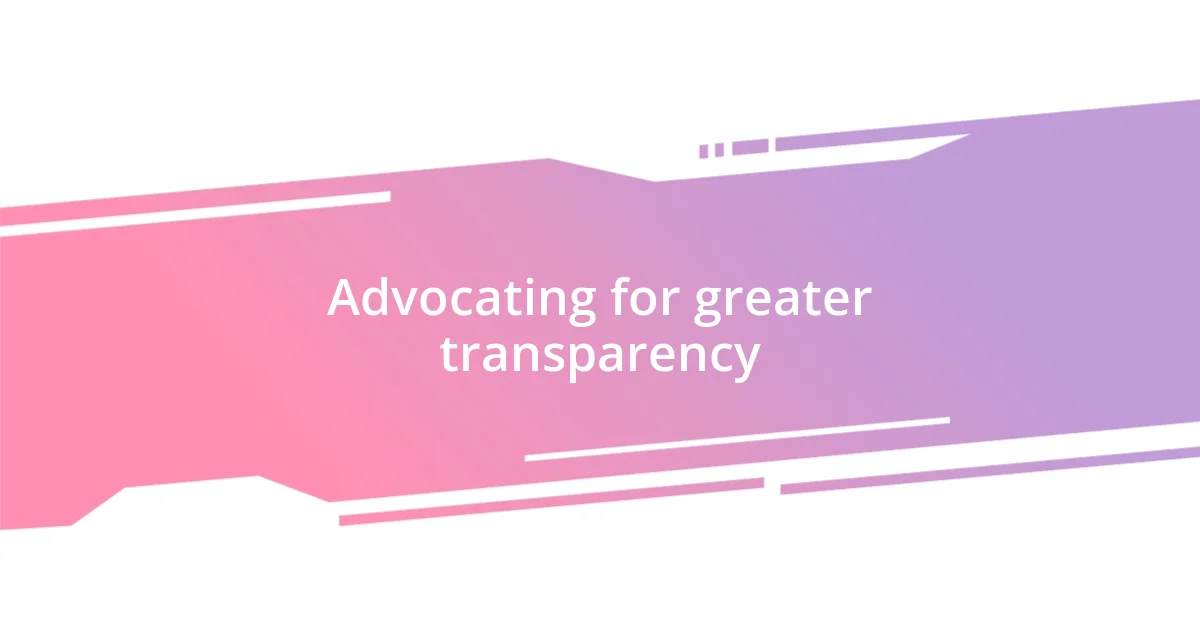Key takeaways:
- Understanding ethical jewelry includes concepts like fair trade, conflict-free sourcing, and supporting local communities, emphasizing the need for consumer awareness in purchasing decisions.
- Researching sustainable materials reveals options such as recycled gold, lab-grown diamonds, and ethical gemstones that promote environmental responsibility and social equity.
- Advocating for transparency in the jewelry industry empowers consumers to demand clarity on sourcing practices and labor conditions, fostering accountability and ethical standards among brands.

Understanding ethical jewelry concepts
Ethical jewelry revolves around the idea of making conscious choices that prioritize sustainability and social responsibility. I remember the first time I learned about the adverse effects of conventional jewelry mining. The thought of communities suffering and ecosystems being damaged really struck a chord with me. Isn’t it sobering to think that something we cherish can come at such a high cost?
Understanding the concept of fair trade in jewelry was another eye-opener for me. It wasn’t until I participated in a local artisan fair that I truly grasped how much passion and care go into ethically sourced pieces. Each item told a story, connecting me to the craftspeople behind them. Have you ever held a piece of jewelry and felt that unique connection? It can be incredibly empowering to know that my purchase supports ethical practices and fair wages.
Additionally, the term “conflict-free” often comes up in ethical discussions. Initially, I found it confusing. What exactly constitutes being conflict-free? I learned that it refers to sourcing materials, particularly diamonds, that are not funding violence or human rights abuses. Understanding this aspect has reshaped how I view not just jewelry, but the entire industry. Isn’t it reassuring to consider how our choices can promote peace and justice?

Researching sustainable materials
Researching sustainable materials has been eye-opening for me. The variety of options available is truly impressive. For instance, when I first stumbled upon recycled gold, I was thrilled to discover that it reduces the need for new mining activities. It felt like a win-win situation. Who wouldn’t want to wear something beautiful while knowing it’s helping the environment?
When diving into the world of lab-grown diamonds, I had mixed feelings initially. My preconceived notions about their value were challenged. I learned they are chemically identical to natural diamonds but produced through sustainable practices. This shift in perspective was enlightening. It made me reflect on what truly holds value in jewelry— is it the stone’s origin or the meaning behind it?
As I continued my research, I kept coming across terms like ethical gemstones and their sourcing, which often involve supporting local communities. It warmed my heart to realize that when I purchase such gemstones, I contribute to sustainable livelihoods. I then began to see my jewelry collection not just as adornments, but as tokens of ethical storytelling, each with a background that resonates. Isn’t it wonderful to think that we can wear pieces that reflect our values?
| Material | Sustainability Aspects |
|---|---|
| Recycled Gold | Minimizes mining, reduces waste, uses existing materials |
| Lab-Grown Diamonds | Same quality as natural diamonds, environmentally friendly production |
| Ethical Gemstones | Supports local communities, responsible sourcing practices |

Discovering artisan ethical jewelers
Discovering artisan ethical jewelers has truly transformed my perspective on jewelry shopping. I recall visiting a small workshop where an artisan crafted stunning pieces right in front of my eyes. Watching her skillfully shape each item with such love and attention made me appreciate the artistry and dedication behind ethical jewelry. It was a stark contrast to the mass-produced pieces I often saw in stores.
Here’s why I find artisan jewelers so compelling:
- Unique Designs: Each piece is often one-of-a-kind, reflecting the artisan’s personal touch and creativity.
- Story Behind the Piece: Knowing the background of a piece, from its design inspiration to the materials used, adds depth to my jewelry collection.
- Community Support: Buying from artisans contributes to local economies, allowing craftspeople to sustain their livelihood.
- Ethical Practices: Many artisan jewelers prioritize sourcing materials that align with fair trade and sustainability principles.
I cherish the feeling of connecting with the maker through their work. When I wear these pieces, it goes beyond mere adornment; it represents a shared commitment to ethical practices. Each time I put on an ethically crafted piece, I feel like a part of a larger movement advocating for change in an industry often overshadowed by exploitation.

Evaluating ethical certifications
Evaluating ethical certifications can be a bit overwhelming at first, but I think it’s crucial for making informed choices. When I began my journey, I found myself staring at labels that promised sustainability and fairness. I wondered, how can I differentiate between genuine certifications and mere marketing lingo? Ultimately, I learned to favor certifications like Fair Trade and Responsible Jewelry Council, as they have rigorous standards ensuring ethical practices throughout the supply chain.
As I dug deeper, I started comparing the criteria behind various certifications. For example, while some focus on environmental sustainability, others emphasize fair labor practices. I remember reading about the Metal Recyclers Association, which certifies jewelry made from recycled materials, and it struck me how interconnected these aspects are. They all reflect a commitment to a better world and urge consumers like me to support brands that truly care about their impact.
It’s not just about choosing a shiny piece of jewelry; it’s about aligning my purchases with my values. Familiarizing myself with these certifications has empowered me to ask the right questions when shopping. What are the sourcing practices? How does the brand support workers? I’ve found that understanding these elements enriches the entire shopping experience, transforming it from a simple transaction into a meaningful exchange. Isn’t it fulfilling to wear something that aligns not just with your style, but also with your principles?

Supporting fair trade practices
Supporting fair trade practices has become a cornerstone of my jewelry-buying journey. I still remember the moment I learned that my purchase decisions could impact artisans and their communities. It felt like a lightbulb went off in my head—why not choose jewelry that uplifts the very people who create it? Every time I select a piece that supports fair trade, I know I’m contributing to better wages and working conditions for artisans.
I recently visited a fair trade marketplace and was struck by the energy in the room. You could feel the pride radiating from the artists as they shared stories about their crafts. One artisan spoke about how fair trade practices allowed her to afford education for her children. Isn’t it incredible to think that my choice of jewelry could help make a direct difference in someone’s life? I left that day not just with a beautiful necklace, but with a deeper appreciation for the connections my purchases create.
The emotional weight of supporting fair trade practices is profound. When I wear a piece that embodies ethical sourcing, it serves as a reminder of the positive impact I can have. I often find myself wondering—how can I make my purchasing power truly count? Each decision I make at the jewelry counter is an opportunity to challenge the norm and support a more equitable world. It’s not just about aesthetics; it’s about contributing to a movement that prioritizes fairness and respect for all.

Advocating for greater transparency
Transparency in the jewelry industry is something I’ve come to deeply appreciate. I recall a time when I bought a beautiful ring, only to later discover that the source of the stones was questionable. That moment taught me how critical it is for brands to open their doors and share their sourcing stories. When a brand is transparent about where materials come from and who makes the jewelry, it builds trust and allows me, as a consumer, to make informed decisions.
On another occasion, I attended an event where a jeweler spoke openly about their supply chain, detailing every step from mine to market. Hearing them discuss their partnerships with local miners and the impact of their choices made it clear that transparency isn’t just a buzzword; it’s a commitment to accountability. I couldn’t help but think—if more brands adopted this level of openness, we could revolutionize the entire industry. Every detail matters, from ethical sourcing to worker conditions, and consumers deserve to know the full picture.
In my journey, I’ve found that advocating for transparency goes beyond personal satisfaction. It’s about encouraging others to demand the same clarity from the brands they love. I sometimes wonder, if consumers rallied together for transparency, what kind of change could we inspire? It’s empowering to know that our voices and choices can compel companies to uphold higher standards, ensuring that our jewelry not only looks good but also reflects our values.














